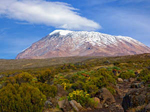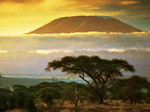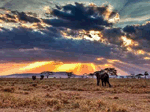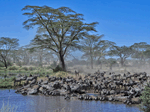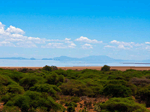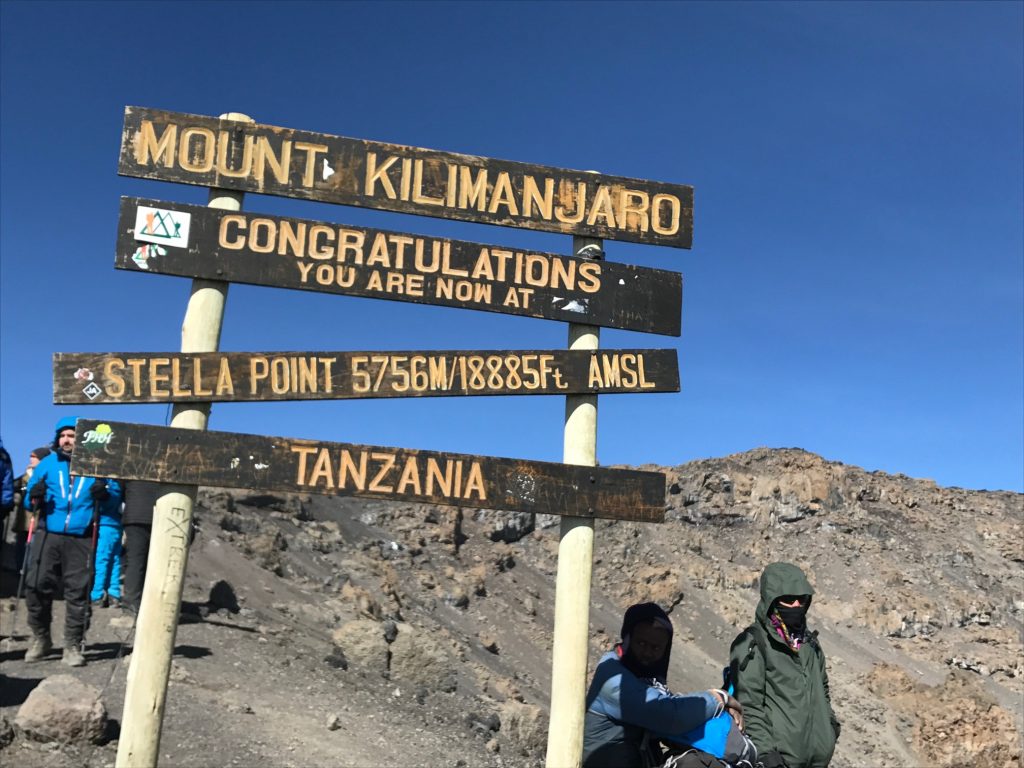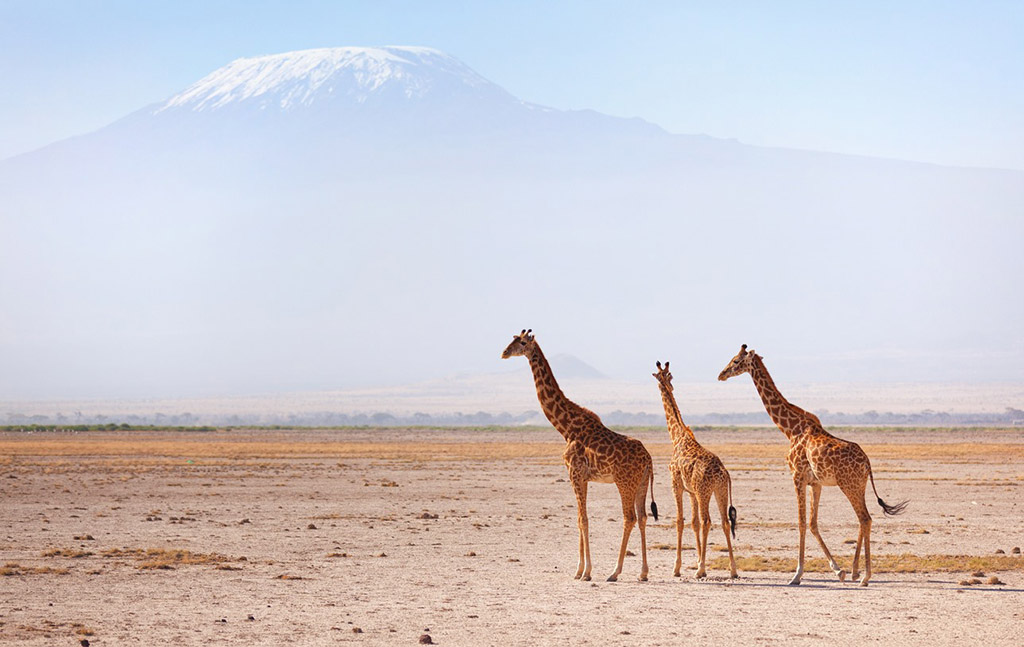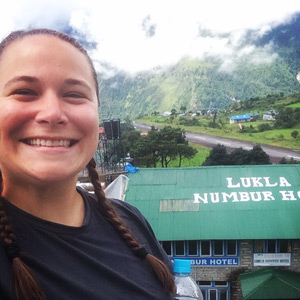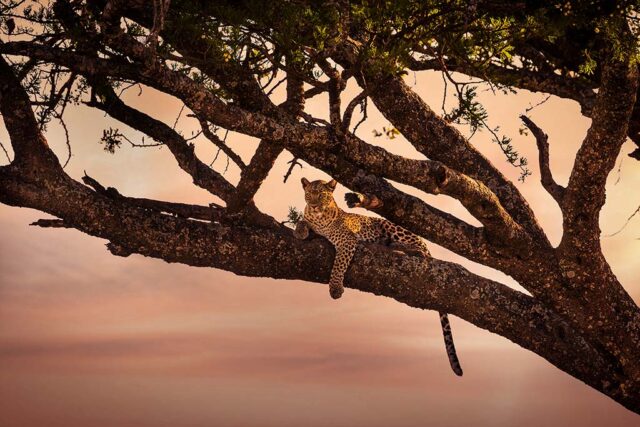
A country rich in world wonders, from Kilimanjaro, the world’s largest free standing mountain, to the Great Migration, where 2 millions wildebeest, zebras and gazelles make their yearly circuit through the world famous Serengeti. From hiking an active volcano, visiting one of the country’s 130 tribes, or spotting the Big Five in one of the world class safari parks, Tanzania has it all. After exploring the hot savanna, relax on the resplendent beaches of the Zanzibar Archipelago before diving into the azure water to see the colorful coral gardens below. After consulting our adventure experts, we bring you the top 20 things to do in Tanzania, one of Africa’s top destinations.
1. Climb Mt Meru
Mount Meru is Tanzania’s second and Africa’s fifth highest mountain, located in Arusha National Park. Coming in at 4566 metres, Kilimanjaro’s “little brother” is often overlooked in the shadow of its famous sister. Though it is a great way to acclimate to high elevation before summiting Kili, there are a great many other reasons to summit this majestic mountain. The only route, Momella, is significantly less busy than Kilimanjaro’s popular trails and provides an ‘off Africa’s beaten path’ experience. With fewer trekkers, the lower slopes are thick with lush vegetation and varied wildlife. Arusha National Park is home to giraffes, monkeys, buffalo, warthogs, and elephants so encountering wildlife on the trail is a common occurrence. The route takes 3-4 days and the views from the crater rim more than make it worth the effort. From the summit there are spectacular views of Kilimanjaro, the sweeping plains and into the crater, several hundred feet below. Though Kili gets the lionshare of the attention for trekking in Tanzania, you won’t regret paying her smaller counterpart a visit.
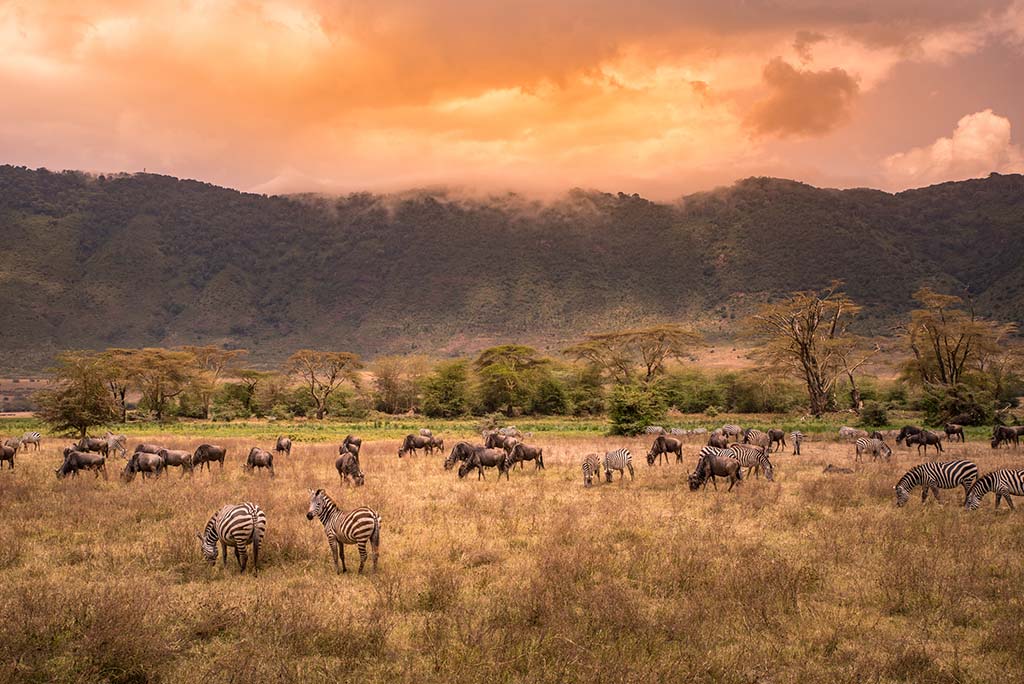
However you look at it, Ngorongoro Crater easily qualifies as one of the world’s greatest natural wonders. It is the largest unflooded and unbroken caldera in the world, and is protected as a UNESCO World Heritage Site. About 20kms across, 600 meters deep and 300 sq kms in area, the Ngorongoro Crater was once a massive volcano thought to have been the size of Kilimanjaro. In addition to being a geological splendor, it’s a natural reserve home to some of the densest large mammal populations found anywhere in Africa. Approximately 30,000 animals such as leopards, cheetahs, zebras, elephants, and hyenas live in the conservation area. The Ngorongoro highlands and the crater offer excellent birding, with over 500 species recorded. It is also a great place to see endangered rhinos and lions. It should be at the top of any Tanzania bucket list.
View: Tanzania Safaris
Ol Donyo Lengai, translating to: The Mountain of God, is a sacred mountain to the Masai people. It rises steeply from the surrounding landscape of crater lakes, dense forests and grassy ridges, streams and waterfalls in Ngorongoro’s Conservation Area. At 10,000 feet it is not the tallest volcano around but it is Tanzania’s only active volcano. It is also unique in its chemical composition, its carbonatite lava is gray and black instead of the usual glowing red you might expect. After a challenging night summit, it’s possible to both see and hear the distinctive lava 100m below the crater rim. It is a dangerous venture to say the least so do your own research beforehand. Come prepared for an epic climb with gloves to protect your hands, broken-in hiking boots with traction for the steep grade, and a warm jacket for the windy summit. Though the ascent is difficult you’ll be rewarded with a dazzling night sky of shooting stars and a stunning sunrise looking down on Lake Natron through the volcano’s steam vents.
Discover Ol Donyo Lengai For Yourself
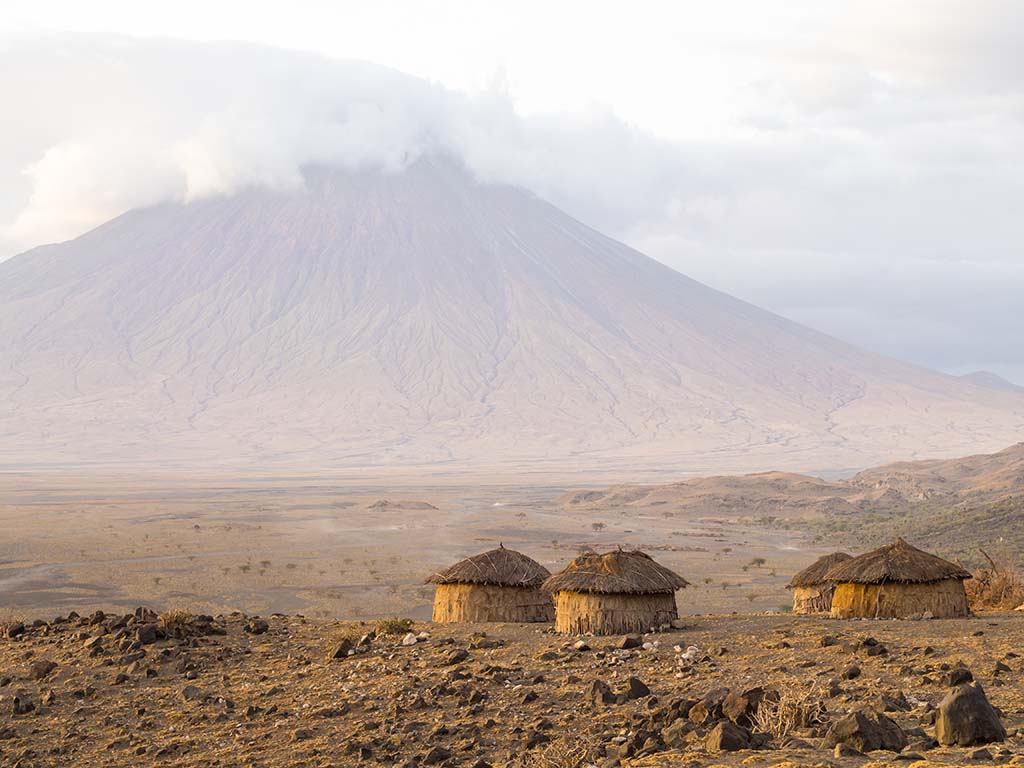
4. Visit an Maasai Village
Easily identifiable by their colorful wraps and sashes, the Maasai tribe is the most widely known tribe in Tanzania. While other tribes gave up their traditional lifestyles to modernity, the Maasai people still live on the plains of East Africa the way their people have for centuries. They live in small mud dwellings called bomas that are constructed by the women of the tribe. Though historically the fierce Masaai warriors fought off outsiders, it is now possible to pay an entrance fee to be given a cultural tour of Maasai villages. The villagers show tourists inside their bomas, their traditional fire making skills, and encourage them to join in on spear throwing competitions, traditional cooking, and beadwork classes. The Maasai women are renowned for their colorful beaded necklaces that symbolize their identities and different statuses in the tribe. Though it’s encouraged to buy a piece of jewelry from the women to support the indigenous community, it is not required. The Maasai are also famous for their jumping dance, originally performed by the tribe’s warriors to show off to the women. A singing circle is formed and as the voices crescendo the jumper goes higher and higher in an impressive display of agility. Visiting a Maasai village is an amazing opportunity to see a culture wholly different than your own. One that steadfastly adheres to their values of community, courage, selflessness to overcome any challenges that the vast savannas of Africa bring.
This high altitude camp, situated at a whopping 18,865 feet above sea level is an otherworldly arctic landscape only 475 feet shy of the summit. It’s the best location for exploring the icy crevices of Furtwangler Glacier and is an uncommon deviation from the usual routes. Adding on an extra day is completely worth it to hike to Reusch Crater and the ash pit, visited only by special request and unknown to the vast majority of Kilimanjaro’s trekkers. But it’s not an excursion without risk, to stay a night in this moonscape it’s requisite you come properly acclimated. The dangers of sleeping so high on the mountain without adjusting to the altitude can be dire therefore all visitors will be monitored closely for signs of AMS.
View: Kilimanjaro Climbs
6. Visit the Rainforests and Villages at Base of Kilimanjaro
In the misty forests and seas of moss covered trees at the foot of Kilimanjaro the villages and banana-coffee gardens of the Chaaga tribes can be found. The volcano creates the optimal climatic conditions for these lush tropical gardens, with nutrient rich soils, a stable temperature and numerous fresh water springs. On a visit to the area it’s possible to learn from a local farmer the process of growing and roasting Arabica, the best seasons and what gives the coffee its full-bodied flavour and smell a.k.a. The reasons that these food products are big business in Tanzania! After discovering why it’s one of the best places in the country to grow bananas and coffee, try some for yourself! Don’t miss the banana beer! It is a specialty of the Chagga people, traditionally concocted for social gatherings such as weddings, births or wakes. Finish off your trip with a brisk dip at the 150m tall Materuni Waterfalls where you might get lucky in spotting a chameleon in the bush dense jungle.
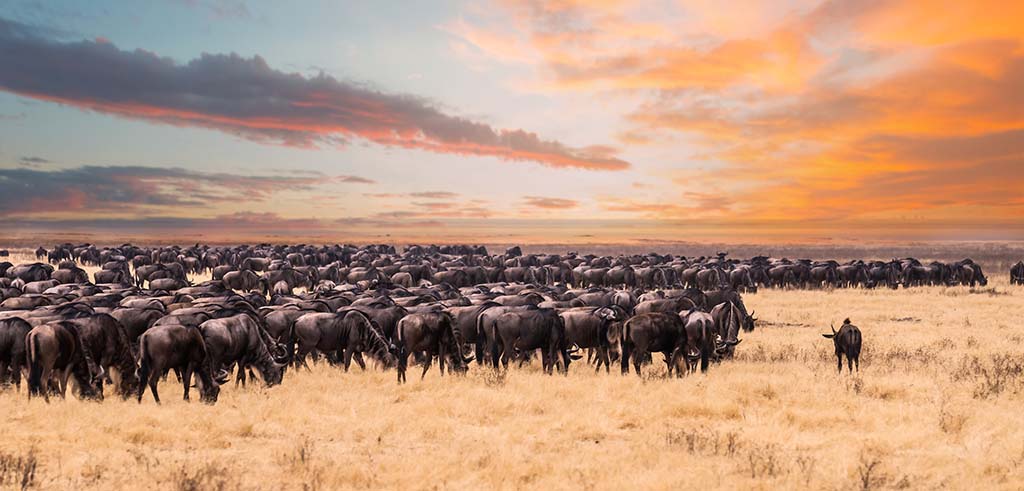
7. The Great Migration
The Great Migration is one of the natural wonders of the world. Each year a staggering 2 million wildebeests looking for greener pastures follow a 1,800 mile (2,900 km) circuit traversing Tanzania and Kenya. And they’re not alone, zebra and antelope follow suit in an epic saga of life and death. While the ungulates move through the country seeking water and fresh grass, they are stalked by lions, cheetahs, and hyenas. Birthing season is when the predators are treated to easy meals as the circle of life is enacted on a massive scale. The river crossings are another incredible sight as the wildebeests and zebras wildly race to avoid the lurking crocodiles or the trampling of their large herds. As a whole the Migration represents the savannas flowing ecosystem at work and witnessing it is unforgettable. It’s no wonder that people are drawn from all across the world to the Serengeti each year.
View: Tanzania Safaris
8.Tarangire National Park
Like the Serengeti, Tarangire is part of the world-famous annual massive migration of millions of wildebeest and zebras following the rains and fresh pastures. Roughly ten times the size of nearby Manyara National Park, it has a concentration of wildlife that is exceptional from July through to October. Although a little off the main safari route, this Tanzania safari park is a gem on the Northern safari circuit. Though Tarangire means ‘river of warthogs’, the park is most famous for its giraffes, birding and a plentitude of baobab trees. It’s authentic, untouched Africa at its best. Above all it offers unrivaled elephant sightings; it is estimated that the park is home to the largest concentration of elephants in the world. Make sure to spend time at the sizable watering hole near the park entrance where the animals congregate together like a scene from the ‘Lion King’.
9. Serengeti Safari
The envy of all safari countries is the Serengeti; Africa’s most famous and Tanzania’s oldest national park. Its name, derived from the Masai language, means “endless plains”. An ecosystem revered for its incredible natural beauty, diversity and unbridled innate wilderness, that begs to be explored. To understand and experience even just a small part of this boundless ecosystem, will change your vision on our world and the environment. The staggering quantity of remarkable wildlife provides excellent animal sightings all year. However, June through October is generally considered to be the best time to visit as you might be able to see the famed Mara River crossings. The Serengeti National Park is also listed in the top 5 places in Africa to see hippos, with innumerable waterholes holding hundreds of wallowing hippos. Keep an eye out for the parks signature umbrella trees and Africa’s big cats when you embark on your Serengeti safari.
View: Tanzania Safaris
10. Visit Gombe National Park’s Chimpanzee
Gombe National Park is famously known as the place where Jane Goodall’s longest running study of chimpanzees’ social groups took place. It’s Tanzania’s smallest park, occupying a remote, lush area of steep slopes along the edge of Lake Tanganyika across from the Congo. The protected park is home to over 100 chimpanzees and is often ranked as one of the best places to see wild chimps in their natural environment. During the dry season, sightings of the groups foraging are nearly guaranteed on the lower slopes -as long as you are willing to traverse over Gombe’s hills and valleys. As you approach the primates, you’ll be thrilled to hear their hollers echo through the jungle around you. Coming face to face with these wild primates (our ancestors with which we share an incredible 98% of our genes) is undeniably an experience that brings you closer to nature and implicitly makes you question what it is to be human. It also inspires visitors to build a world of respect and coexistence with all living creatures on the planet. It is a photographer’s paradise of scenic lake beaches, surreal landscapes and filled with hippos, snakes, and baboons. For those who grew up watching Tarzan, it means the realization of childhood dreams.
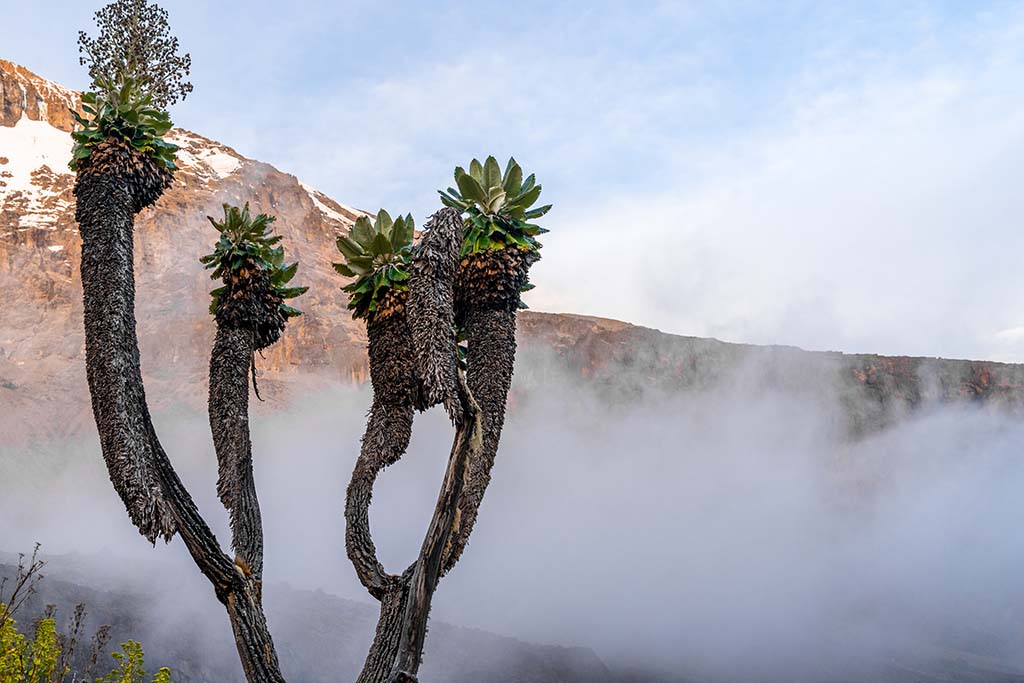
11. Unique Flora of Kilimanjaro
One of the most distinctive features of the Kilimanjaro trek are giant lobelia and groundsels found in the Alpine zone of Kilimanjaro at roughly 12-14,000 feet. The giant lobelia rosetta-like spikes can reach an incredible height of 10 feet. In order to combat the extreme cold at the high altitude the plants have evolved to close its leaves at night.
The giant groundsels, or Senecios, a strange, prehistoric looking plant that grows up to 30 feet tall. These intriguing flora have evolved in isolated circumstances giving Kilimanjaro, and other free standing high altitude mountains, the title of a ‘biodiversity islands’. Though neighboring mountains have similarly evolved groundsels, the ones endemic to Kilimanjaro are genetically unique. These enchanting plants offer mesmerizing photo opportunities to those who trek Africa’s tallest mountain.
View: Kilimanjaro Climbs
12. Olduvai Gorge
Olduvai Gorge is a UNESCO World Heritage site and one of the world’s most important paleoanthropological sites. Known as the “Cradle of Humanity”, it’s where the earliest evidence of human ancestors has been found. Their existence here informed us that our species, homosapiens, originate from Africa. The site itself is a 30 mile long ravine, located between the Ngorongoro Crater and Serengeti National Park inside the Great Rift Valley. Countless fossilized bones and stone tools, over a million years old, have been found in this gorge. Visit the museum to see the intriguing halls of artifacts and to hear inspiring lectures about the origins of humankind. As the best historical site in Tanzania, adjacent to Serengeti National Park nonetheless, it is worth the visit!
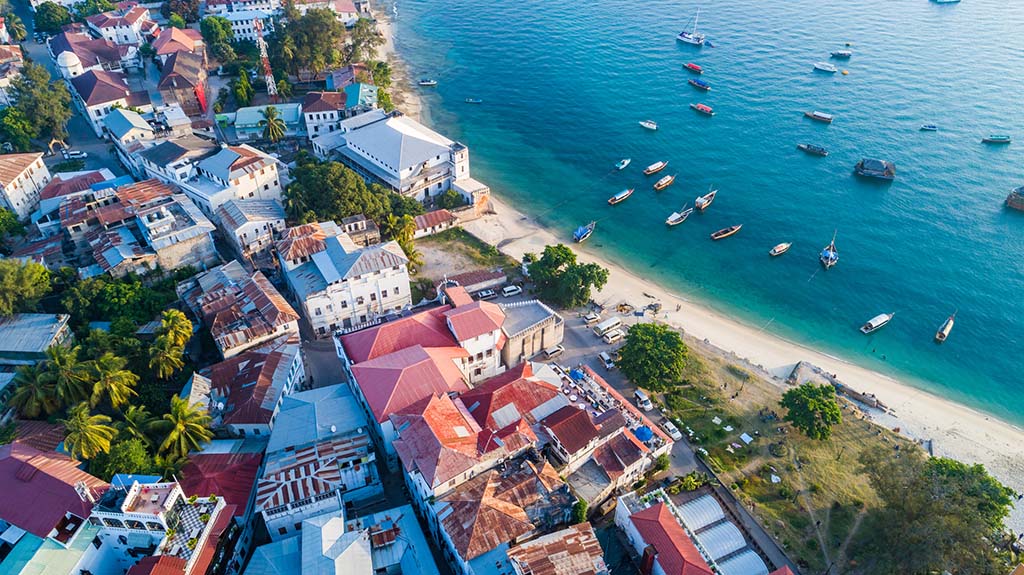
13. Stonetown in Zanzibar
Though it’s not the capital of this autonomous island territory, it is its heart and soul. This exotic city is popular for its bustingly bazaars, markets, delicious street food stalls and beautiful mosques. Originally constructed by Arab slave and spice traders the fascinating city is an amalgamation of Swahili, Arab, Persian, Indian, European and African architecture. Walking through the intimate, maze-like alleys and crumbling facade of the Old Fort, you’ll not be surprised to find the entirety of Stone Town is a UNESCO World Heritage Site. The most popular thing to do is to explore the winding, narrow streets that are only accessible by foot traffic. It’s an eclectic world of colorful stained glass windows, ornate balconies, and intricately carved wooden doorways. Around every corner you might chance coming face to face with a donkey or a friendly local greeting you with another ‘mambo’ as you pass them again for the umpteenth time. Make sure to try the infamous Zanzibar pizza and the local coffee and spiced tea, ideally while catching a sunset from one of the city’s rooftop terraces. Additionally, it’s worthwhile to add a sobering visit to the slave market museum or a spice tour (afterall, it is what the island is nicknamed after) before you head off to one of the island’s paradisiacal beaches.
14. Safari at Lake Manyara
One of Tanzania’s smaller parks, Lake Manyara is a lesser known gem. It is primarily known for its birding opportunities, a rare type of tree climbing lion, and a healthy baboon population. The lions, when they are found, have an unusual and inexplicable habit of resting during the day high in the parks’ fig and acacia trees. If you’re unable to find any lions, you can still depend on seeing members of the sizable baboon population as they are a frequent sighting in the park. Keep your eye out for incredibly cute dik diks and enormous ostriches that can be found running around the park. A helpful tip is to plan to visit during the dry season when there are fewer water sources and the animals are forced to congregate close to them. If you do happen to be visiting during the rainy season, don’t fret as this is when the park has the most birds. Most notably, flocks of rose hued flamingos can be seen preening along the gray shores of Lake Manyara. If you have already been on several safaris, consider taking a night safari here as Lake Manyara is the one of the few parks that has specialized operations for driving around inside the park at night. Nocturnal predators such as leopards, hyenas, and lions are all on the prowl in the early hours of twilight. Though omnivores such as bush babies, civet cats and aardvarks skulk quietly through the shrub to avoid detection, it’s fairly common to encounter them on a night drive. Day or night, Lake Manyara is a beautifully diverse park to explore.
15. Relax in Moshi
Tucked into the foothills of Kilimanjaro lies Moshi, otherwise known as ‘The Gateway to Kilimanjaro’. It’s a sleepy town where you could spend the mornings strolling through the street markets looking for a kanga or local crafts, the afternoons at the art galleries and the evenings behind a booth at an upbeat karaoke bar. If you’ve got time before or after your Kilimanjaro trek (which is what inevitably draws most of Moshi’s foreign crowd) consider going on a short day trip. Great options near Moshi include going to the turquoise hot spring oasis of Kikuletwa or kayak across Lake Chala to reach Kenya on the other side. After a full day of adventuring, wind down with some fresh fruit for dessert; the mango, passion fruit, papaya, and pineapple are both fresh and lucious.
16. Lake Natron
Your first view of Lake Natron with Ol Donyo Engai through Tanzania’s haze will seemingly transport you back in time 10,000 years. The barren landscape and the views of the volcano can be otherworldly. What’s more is that Lake Natron is a crimson vision -turned blood red by salt loving microorganisms that thrive in the hot alkaline waters. This caustic, shallow lake burns the eyes and skin of animals not adapted to its acidity. However, from Sept to October a spectacular congregation of 2.5 million lesser flamingos inhabit the hostile lake’s small islands. This unlikely habitat is their breeding ground and the high ph offers natural protection against predators. In addition to seeing the colorful plumage of the lesser flamingos, the lake is also the location of the “Dance Hall”, a rare Paleontological find. It is a huge collection of footprints from an estimated 40 homo sapiens from over 19,000 years ago found on mudflats on the southern shore of Lake Natron. If you have an interest in humanity’s prehistory then make sure not to miss the biggest collection of human footprints found in Africa. Lake Natron is a uniquely beautiful environment and can be a destination added onto any Serengeti safari or expedition to the Ol Donyo Lengai volcano.
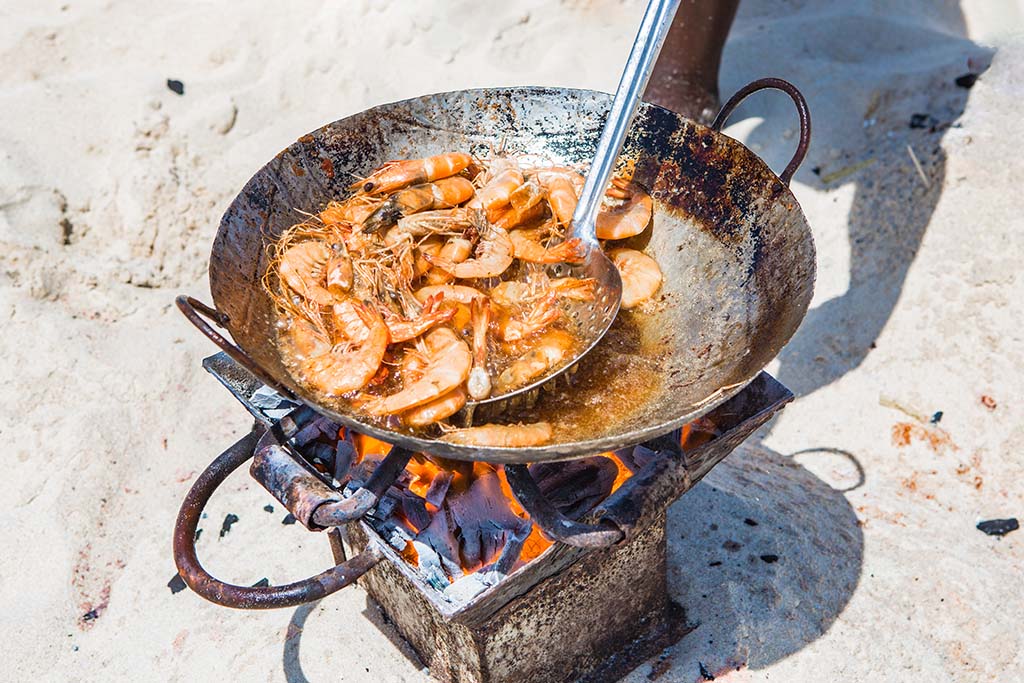
17. The Taste of Tanzania
Tanzania has a wide array of foods but a national staple and a ‘must try’ is Ugali. A starch with the consistency of mash potatoes that’s rolled into a ball and dipped into various sauces of meat, fish, or vegetables. A typical Tanzanian’s diet is meat heavy with few fresh vegetables; for a special meal one might have a goat barbeque. Though if you’re missing the crunch of fresh vegetables there’s no lack of international options in the large multicultural cities. With the plentitude of coffee and tea plantations it’s no surprise that coffee and chai are the country’s favorite brews. However, if you choose to drink water instead make sure it’s bottled, boiled or purified with tablets.
However, if you’re a real gourmand we suggest you head to Zanzibar, the Spice Island. Zanzibar proves itself as the country’s culinary capital with a fusion of seafood, spices, fruit, herbs, and spices in their dishes, all sourced from the island. Mouth watering combinations of spicy curries accented with cinnamon, cloves, nutmeg, are popular Zanzibari options. Eat freshly picked fruits such as coconuts, jackfruits and mangoes (after making sure they were washed with clean water). Enjoy a variety of juicy seafood at the night markets, such as fish, lobster and even octopus cooked on skewers above an open fire.
Protip: Eat with your right hand (not left), never clear your entire plate and always have at least a taste out of respect.
18. Zanzibar Beaches
The soft coral beaches of Zanzibar are one of the main reasons why visitors flock to the island. These white sand beaches are perfect for honeymooners, backpackers and families alike. Due to the island’s size they are all within an hour or two’s drive of Stone Town with frequent and affordable public transportation to shuttle you there. Plan your trip around the ‘long wet’ rainy season from March ’till May to get ideal beach going weather. That way Zanzibar, an island of vibrant reefs, ideal for snorkeling, and beaches, ideal for napping in the sun, will surely sweep you off your feet.
The majority of the world class, powdery white beaches and expensive resorts are located on the North east side of the island, although the entire perimeter of the island has stunning coastline and beach options. On the Northern side the stunning Nungwi and Kendwa, popular with the younger crowd for its full moon parties, can be found. On the east side of the island there’s Bwejuu Beach, wild and remote, and Pongwe, considered to be one of the best and most tranquil beaches in Zanzibar. Lastly on the east side there’s Paje, a young, hip area with a coffee shop, affordable hostels, good food and above all, kitesurfing! On the southeast side the quaint fishing village of Jambiana is a delight to explore (keep in mind that on this muslim island it’s inappropriate to wear your swimsuit anywhere but on the beach). And the last noteworthy beach we recommend to you is Kizimkazi in the South. It’s idyllic and is possibly the best place on the island to swim (though we discourage guests from joining in on the unethical dolphin tours).
Pro tip: The island is accessible from the mainland by a short flight or an affordable ferry from Dar es Salaam.
19. Visit Pemba Island
Pemba is known as “The Green Island” for its rolling hills, verdant valleys, and plentiful spice production, primarily cloves. Locally it is known as a magic island of spirits, receiving far fewer visitors than its bigger counterpart island, Zanzibar. With limited tourists, a flourishing environment, and decadent beaches, it’s undoubtedly an untouched African gem. However, Pemba’s main allure isn’t landbased but offshore; it’s renowned for its pristine dive sites. Enjoy exploring underwater gardens of sea fans one moment and spotting hammerheads the next. The gyrating shoals of big fish including sailfish, marlin and spearfish swarm around the healthy reefs. After your first dive it’ll be easy to see why it’s considered to be the best diving on the continent. Enjoy a day sailing through turquoise water filled with wild dolphins, barracudas, and green sea turtles. If you’re visiting the island from September-December find a local outfitter to help locate whale sharks and manta rays, seasonal visitors to the island.
Pro-tip: For those who have a larger budget consider checking out the island’s stunning underwater rooms and fall asleep surrounded by fish.
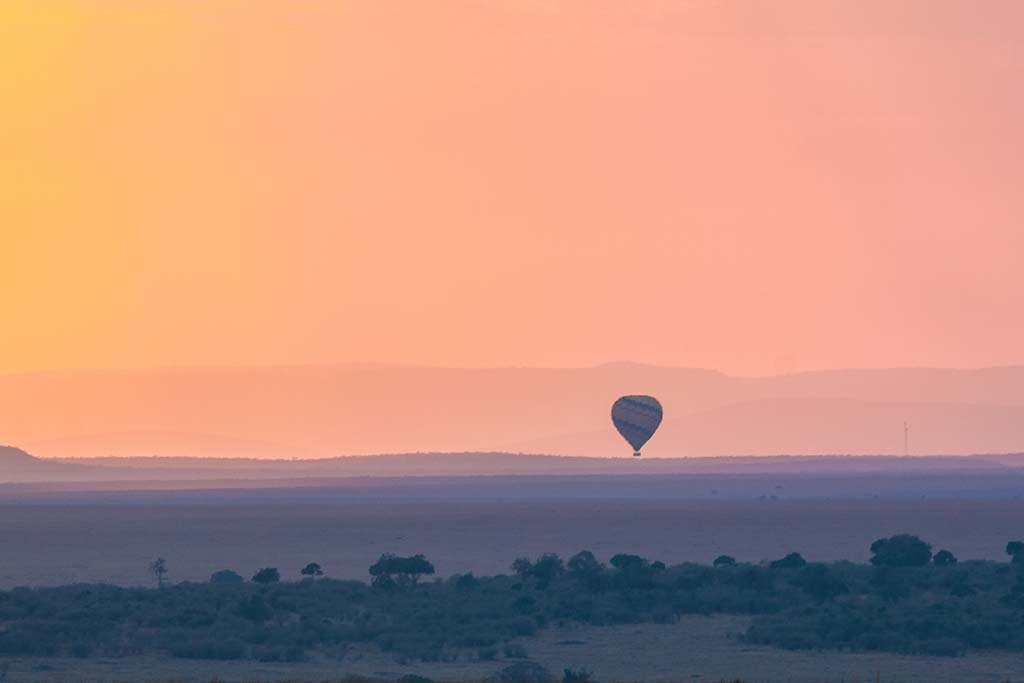
20. Hot Air Balloon Ride Over the Serengeti
Taking a hot air balloon ride of the Serengeti is a once in a lifetime experience that many only dream of. You’ll be wide awake with excitement despite the early morning (4am) wake up call. Watch for nocturnal creatures such as aardvarks and bush babies as the safari jeep jostles towards the departure site. Soon enough, cold dense morning air pushes the buoyant balloon in a moment of lift and then you’re smoothly floating 20, then 1000 ft above the vast plains. The dream-like pastels of dawn transform into vibrant hues above the golden plains. Below life in the Serengeti goes on as usual. That is to say, you might get a birds eye view of big cats hunting, elephants roaming, while gazelles and zebras graze in vast numbers. This indescribable flight gives riders the ultimate vantage point for photographing the park’s big 5; lions, rhinos, leopards, elephants and buffalo. This is especially true at dawn when predators are most active. Furthermore, it lends the opportunity to see different areas of the park that are inaccessible to vehicles required to stay on the roads. Though the most popular time to go hot air ballooning over the Serengeti is when the Great Migration arrives, it is unquestionably breathtaking year round.
View: Tanzania Safaris
With the wealth of wildlife and adventure activities available, you could never go wrong with a Tanzanian getaway. Let us know if you found this guide helpful and what your favorite adventures in Tanzania are! The adventure consultants here at Trekkinghero always look forward to helping guests with questions or with planning their trips. Don’t hesitate to reach out by clicking on the chat box in the bottom right hand corner of your screen. Please like, comment, and subscribe to our mailing list to let us know how we’re doing. We’d love to hear from you!
